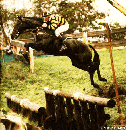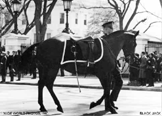

Table of Contents
 From the time of the founding of the Olympic Games in Ancient Greece in 680 B.C., equine events have been central to the
competition. The Olympics were discontinued in Roman times when Asian invasions destroyed both the Empire and Olympia.
In 1896, the Olympics were restored in Athens, Greece; but the first four Olympics did not include equine competition.
From the time of the founding of the Olympic Games in Ancient Greece in 680 B.C., equine events have been central to the
competition. The Olympics were discontinued in Roman times when Asian invasions destroyed both the Empire and Olympia.
In 1896, the Olympics were restored in Athens, Greece; but the first four Olympics did not include equine competition.
In 1912, when the Olympics were held in Stockholm, the horse once again became a part of Olympic competition through the vigorous efforts of Count Clarence von Rosen. The Olympic classes include individual dressage, team 3-day event, and individual and team jumping classes, with each nation entering a team of six riders.
Not only was Count von Rosen instrumental in re-establishing equestrian events in the Olympics, he was also a participant in the 1912 games, and served as a member of the international jury for equestrian competition in the 1924, 1932, and 1936. He also served as a member of the International Olympic Committee, and as honorary chairman of Federation Equestrian International, the world governing body for equestrian competitions, from 1935 until his death in 1955.
The Olympics Have Given Modern Equestrian Competition A Spirit and Excitment In Reaching Heights Of
Excellence For Both Horse and Rider
In the modern Olympics, the national teams are reduced to four competitors in the Prix des Nations Jumping Event, Three-Day
Event, and Grand Prix Dressage. From 1912 to 1948 most equestrian competitors were cavalrymen. With the dissolution of
most cavalry following World War II, however, civilian competitors became most prominent as evidenced by the Olympic
Games held at Helsinki in 1952. Equestrian events are the only Olympic competition in which men and women compete on
an equal basis. The Olympics have created a forum for international equestrian competition which provides a great stimulus for
individual and team achievement.
On a shoe-string budget, the USET fielded a team for show competition in 1950, and three members - Norma Matthews, Arthur McCashin, and Carol Durand - were winners in the low-score competition at the National Horse Show that year. The team made its first appearance in the Olympics at Helsinki in 1952, and they brought home two bronze medals. The first Olympic team included Arthur McCashin, William Stienkraus, and John Russell.
In spite of the financial obstacles, the USET has grown to be one of the major forces in international equestrian competition. Under the rules of the International Equestrian Federation (the F.E.I.), each country may nominate four team members for dressage, five for combined training, and five for show jumping. Competitors are selected for individual competition and there is no standing team.
Few riders can afford to devote all of their time to amateur competition due to the great expense. The USET's permanent headquarters are at Glandstone, New Jersey, and South Hamilton, Massachusetts.
 Driving a horse-drawn vehicle was once as much a part of everyday life as driving an automobile is today. Driving skills were the
subject of study, practice, and refinement. At the turn of this century, organized driving competition gained popularity in both
Europe and America. The 1901 International Horse Show at the Olympia in London included driving competition for singles,
pairs, tandems, and teams of four, but is was not until 1970 that the American Driving Society established the rules governing
competitive pleasure driving.
Driving a horse-drawn vehicle was once as much a part of everyday life as driving an automobile is today. Driving skills were the
subject of study, practice, and refinement. At the turn of this century, organized driving competition gained popularity in both
Europe and America. The 1901 International Horse Show at the Olympia in London included driving competition for singles,
pairs, tandems, and teams of four, but is was not until 1970 that the American Driving Society established the rules governing
competitive pleasure driving.
Competitive driving tests the skill of the driver and the training of the horse. There are three classes: presentation and dressage;
marathon cross country; and obstacle driving. The rules for these competitions were originally drawn up in 1969 by Federation
Equstre Internationale, the international governing body for all horse sports. Like many other equestrian sports, competitive
driving has encouraged the pursuit of excellence in driving skills, breeding of horses for competition, and vehicle design. In
1988 competitive driving became an world championship sport. At present, competetive driving is not included in Olympic
equestrian events.
 The first Pony Club was established in England in 1928 and quickly gained popularity. There were 337 branches and
30,000 members in Britain in 1978. The United States Pony Clubs, Inc, was organized in 1956 after the British example. By
1996, there were 612 local clubs in the United States with about 13,462 members. The purpose of the Pony Club is to teach
riding and the care of horses and ponies to those under 21. The Pony Club also sponsors camps. Many competitive riders have
gained their basic skills in the Pony Club. Canada also has an active Pony Club.
The first Pony Club was established in England in 1928 and quickly gained popularity. There were 337 branches and
30,000 members in Britain in 1978. The United States Pony Clubs, Inc, was organized in 1956 after the British example. By
1996, there were 612 local clubs in the United States with about 13,462 members. The purpose of the Pony Club is to teach
riding and the care of horses and ponies to those under 21. The Pony Club also sponsors camps. Many competitive riders have
gained their basic skills in the Pony Club. Canada also has an active Pony Club.
For more information on the US Pony Club, visit there web site.
 The profound grief of Americans at the death of President John F. Kennedy was accentuated by the sight of Black Jack, the
riderless horse with boots reversed in the stirrups, a symbol of a fallen hero. Black Jack was the last horse issued to the Army
by the Quartermaster, and he was the last to carry the "U.S." brand common to all army horses. Like so many
thousands of army horses, his breeding was unknown. He was foaled on January 19,
1947.
The profound grief of Americans at the death of President John F. Kennedy was accentuated by the sight of Black Jack, the
riderless horse with boots reversed in the stirrups, a symbol of a fallen hero. Black Jack was the last horse issued to the Army
by the Quartermaster, and he was the last to carry the "U.S." brand common to all army horses. Like so many
thousands of army horses, his breeding was unknown. He was foaled on January 19,
1947.
Black Jack was sent to the Third Infantry (The Old Guard) from Fort. Reno, Oklahoma, in 1953. He was named after General
John J. "Black Jack" Pershing, Supreme Commander of the American Expeditionary Force in World War I.
Black Jack served in ceremonial functions, participating in the funerals of Presidents Hoover, Kennedy, and Johnson, General
Douglas MacArthur, and thousands of others in Arlington National Cemetery. Black Jack was semi-retired on June 1, 1973,
and died February 6, 1976, at the age of 29. His ashes were placed in an urn at his monument at Fort. Meyer, Virginia.
- Xenophon
To find out about many of todays major breeds, we recomend a stop at Oklahoma State University's "Horse Breeds" web site.
Next Exhibit - The Horse in Sport